Updated March 24, 2021
What drives the success of a sales department? There are 6 main objectives for any dealership sales department — image, sales, gross margins, expenses, used turnover and new turnover. If you ask Dr. Jim Weber which of those objectives is the most important — and most overlooked — by dealers, it’s developing and growing the business through a professional image within the organization. This requires, “developing a culture based upon unrelenting standards and high expectations. This where I think most dealers fall apart,” he says.
Glossary
Image (n.) — 1. A set of meanings by which a dealership is known and through which people describe, remember and relate to it. 2. The net result of the interaction of a person’s beliefs, ideas, feelings and impressions about the dealership.
Culture (n.) — 1. The shared philosophies, ideologies, values, beliefs, assumptions, expectations, attitudes and norms that bring a dealership together and which in turn represent the behavior patterns or style of the dealership. 2. An outcome of how people relate to one another which in turn is a function of the degree of SOCIABILITY and SOLIDARITY that exists within the dealership.
All the other measurements of success — the metrics listed as the other objectives — can follow suit with the right culture and image in place. “The culture is going to drive the image that exists within that organization. It’s not going to be the metrics, as much as I love them. It’s not going to be the numbers. It’s not going to be the goals,” Weber says. “It’s about you as the dealer principal and as the sales manager, taking charge and developing a healthy culture based on high expectations and unrelenting standards and not leaving individuals who can drive the business down because they have a poor attitude or talk negatively about the dealership, their co-workers, the manufacturer or the machines that they’re selling.”
There are 8 factors that impact the dealership’s image. Five of them are internal and include: Employee Satisfaction, Identification, Communications, Policies & Procedures, Culture. The other three are external: External Communications, Previous Product Experience and Other Channel Members. Together, these factors determine the image of your dealership and are thus directly tied to customer satisfaction.
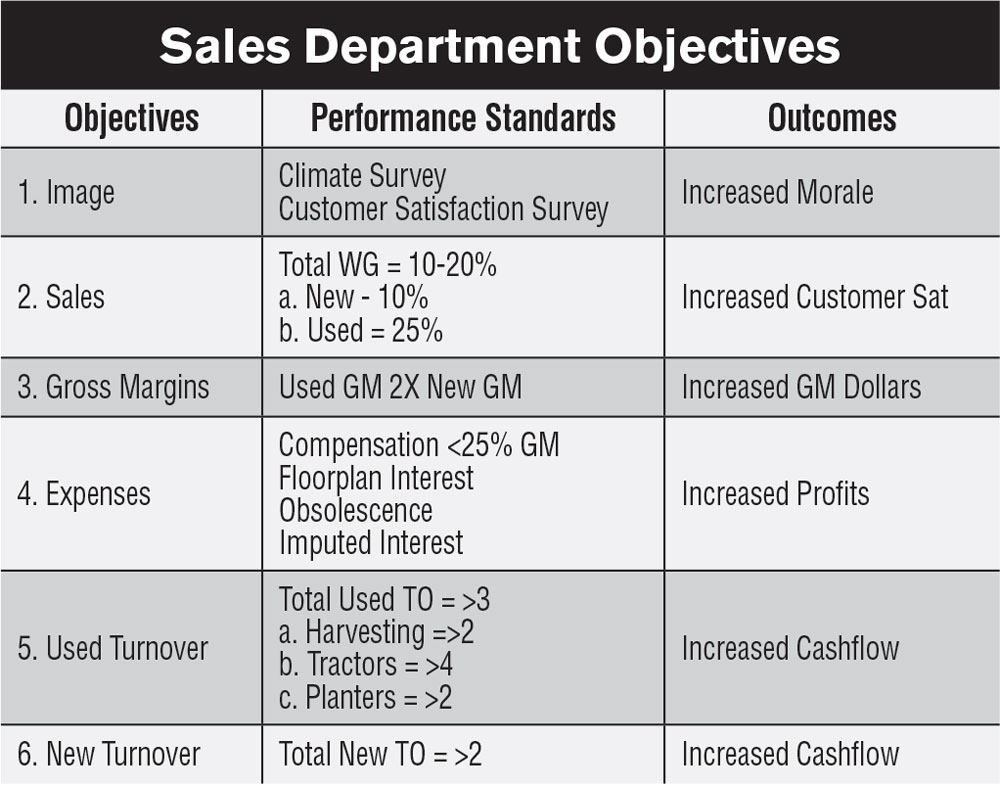
Of the 6 sales department objectives, Dr. Jim Weber says image is the most overlooked, but it is also integral to success. Click to enlarge photo
“Customer satisfaction is nothing more than a manifestation of employee satisfaction. You show me dealership that has high, great employee satisfaction, I’m going to show you a dealership that has great customer satisfaction. Show me a dealership that has poor employee satisfaction, I’m going to show you a dealership that has poor customer satisfaction,” Weber says.
1. Employee Satisfaction
To gauge employee satisfaction, Weber says to ask yourself — and your sales force — 7 questions. Ask any employee in the organization if they truly enjoy coming into work every day. Weber says if they can affirmatively answer that question — with enthusiasm — you’ve got a home run. Similarly, they should view the customer as the most important component of the business.
7 Questions to Ask to Measure Employee Satisfaction & Develop a Professional Image
- Does your sales force truly enjoy coming to work every day?
- Does your sales force see the customer as the most important component of the business?
- Is your sales force rewarded commensurate with their performance?
- Does your sales force know their duties and responsibilities?
- Does your dealership have a defined mission statement?
- If you do have a mission statement, is it known and lived?
- Does your dealership/sales department reflect the higher standards of housekeeping?
Is your sales force rewarded in proportion to their performance? Regardless of what sort of compensation plan you have in place, Weber says, “Prove to me that the compensation as a percent of the gross margin is under 30%. Prove to me that they are increasing sales. Prove to me that you have the margins that you think you deserve and desire. Then you know what? Keep the system you have.” (For more on compensation plans, see “Compensation Plans: A Tale of Two Dealerships”)
Does your sales force know their duties and responsibilities? Weber says in the farm equipment industry it tends to go two extreme ways. Either salespeople are given a 35-page book of responsibilities and/or duties, or on the other end are given the keys to the truck and are told to go sell something. Make sure the goals, responsibilities and tasks are clear and employees understand what they are and how to do them.
Employee satisfaction is directly driven by the next three factors — identification, communications and policies and procedures.
2. Identification
Identification includes things like signage, clean and branded rolling stock and clean, branded sales vehicles. Inside the dealership, this means having a spotless showroom. The service facilities are organized and the bathrooms are clean. Outside, your lot is segmented and the machines are rotated regularly. Your dealership should be a place people are proud to say they work.
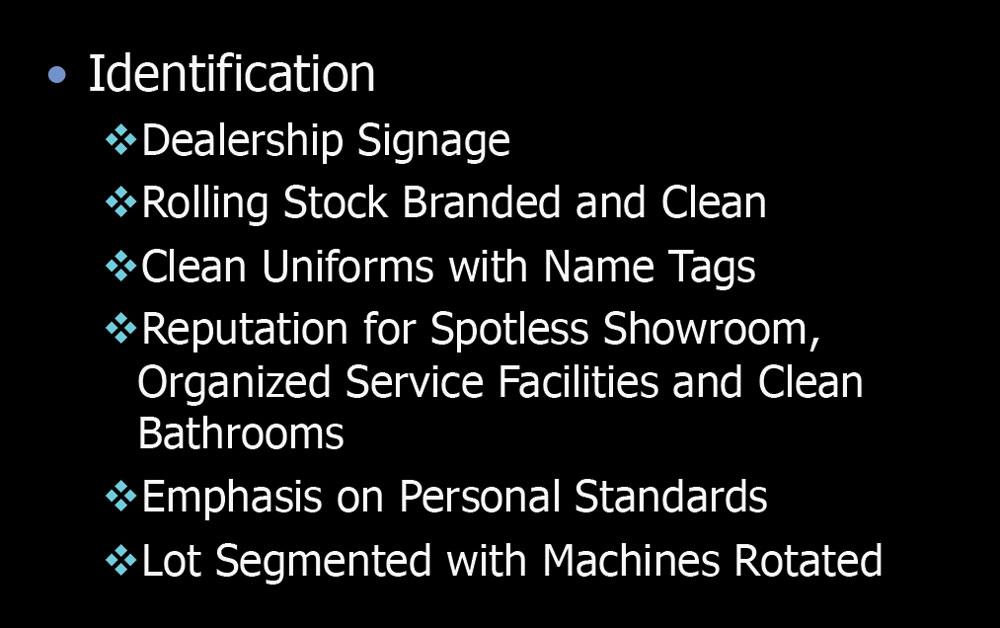
Dealership identification includes signage, clean uniforms with name tags, and a strong emphasis on personal standards. Click to enlarge photo
3. Communications
Communication — both internal and external — is integral to fostering a professional dealership image. It’s also one of the biggest problems at many dealerships. “I have yet to be in a dealership where I sit down with the employees and ask, ‘What’s the biggest problem that you have in this dealership? A lack of communications is always in the top three,” says Weber.
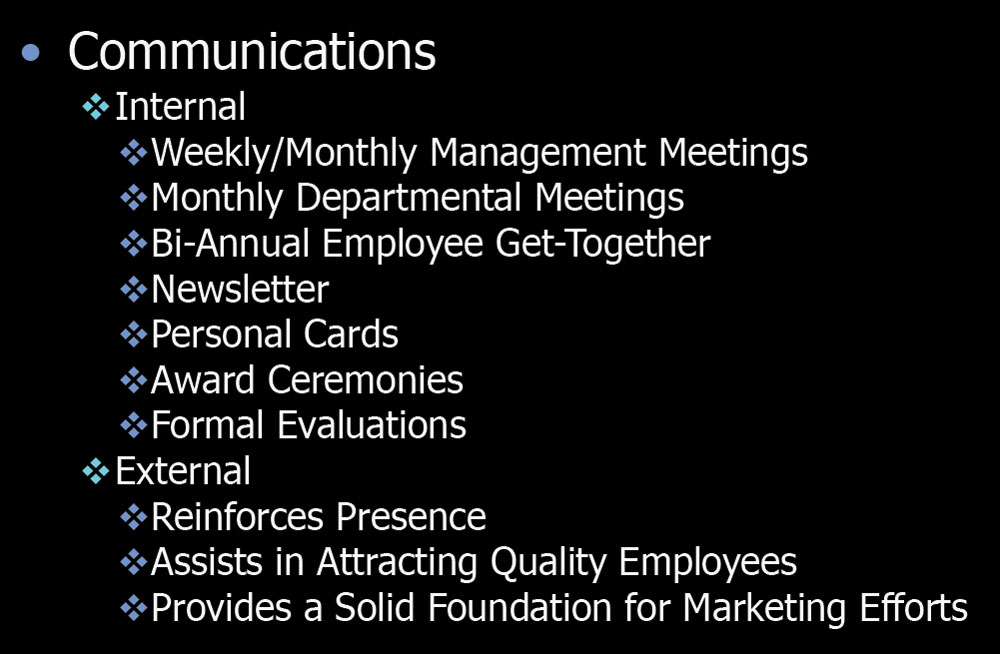
Over communicating is always better than under communicating for both internal and external matters, says Dr. Jim Weber. Click to enlarge photo
Problems never arise from over-communicating. Problems come when you under-communicate, Weber says. From an internal communication standpoint, hold weekly and/or monthly management meetings along with monthly departmental meetings. Host bi-annual employee get-togethers. Start a company newsletter, send personal cards, hold employee award ceremonies and finally have a formal evaluations. These are all different ways to bolster internal communications. In addition, make sure the sales force is informed about your plans that will affect their work. Encourage feedback on how you as a manager are performing. Give timely and honest feedback on employees’ performance. And above all else — listen.
“What I would strongly suggest to any dealership interested in knowing how their employees feel is about once a year, do a climate survey and you get the employees to answer these kinds of questions,” he says. “I break my climate survey down into eight dimensions. I’m looking at how do they assess rewards? How do they assess communications? How do they assess top management? How do they assess mid-level management? How do they assess communications?”
Externally, communication should reinforce your presence in the marketplace, attract quality employees and provide a solid foundation for marketing efforts.
4. Policies & Procedures
The dealership’s policies and procedures should chart a course of action, provide predictability and consistency to actions and serve a key role in clarifying strategy. All departments should have policies and procedures that are clearly defined and logically structured. For a sample of the policies and procedures Weber suggests for the sales department see “Examples of Policies and Procedures for the Sales Department.” Included is making a minimum of 25 sales calls a week and submitting a weekly call schedule and call report. There should be no question of how you get salespeople to follow through, Weber says. “You’re the leader of the team. You indicate to them that one of their responsibilities is to provide you with a call schedule and a call report. There’s no backing up here. This is what I expect. I will expect it to be sent to me every Monday morning. It’s going to be there in my office at a given time. Period, end of the story,” he says.
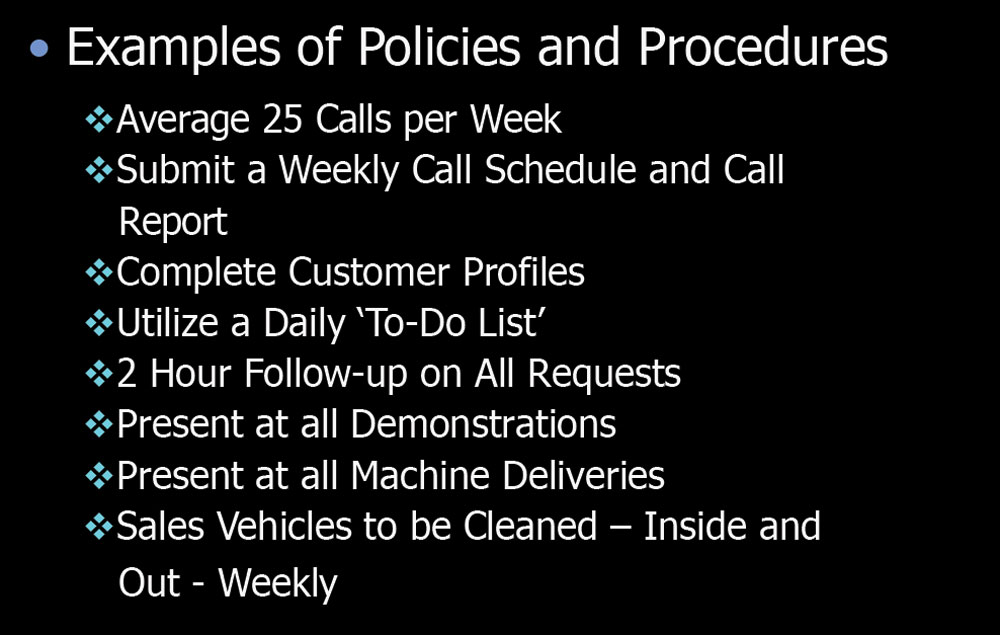
Following policies and procedures is a requirement of the job, and there should be no question of follow through. Click to enlarge photo
Related to policies and procedures, Weber says management should be more concerned with having the right person in the right seat, rather than formal organization and authority. “How many times do we see dealerships with multiple locations take their No. 1 salesperson and make him a store manager or a sales manager, completely devoid of any managerial responsibilities or any ability to do the job. We think because he’s good at selling, he can be a great sales manager. It’s incorrect,” Weber says. “Then rather than giving him the ability to graciously step back and become a No. 1 salesperson again, we let him hang himself out there and we let him alienate the other employees that he’s working with. It’s not right. We have to have the right person at all time in the right seat on the bus.”
5. External Communication
External communication includes confirming or refuting actual perceptions, including gossip, rumors and facts, that exist in the marketplace. This relates to how you respond to what people outside your dealership are saying about your dealership.
6. Previous Product Experience
If there’s a manufacturer problem with a machine your dealership sells, initiate innovative ways to overcome the product deficiencies. Offer a replacement or loaner, but do not criticize the product or the manufacturer. You also need to make sure you’re not criticizing the competition or any other manufacturers. Weber also warns not to commiserate with the customer.
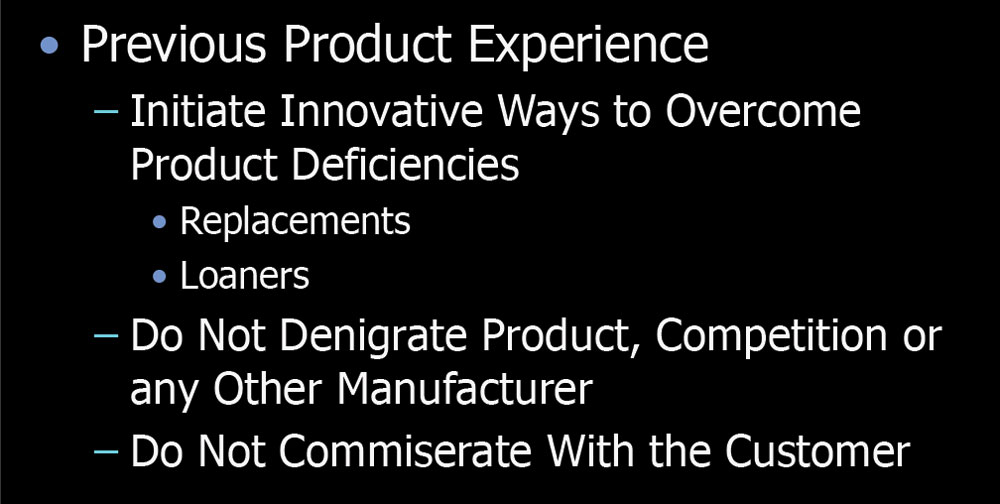
When a problem with a machine arises, don’t talk negatively about the product or the manufacturer. Click to enlarge photo
“I work with some dealers where the service technician wants to go out there and do nothing but degrade the machine. Now again, what is that going to do for the image of that facility? What is that going to do for the image of that dealership? What is that going to do for the image of the manufacturer? What is that going to do about the image of the product that this man just spent 50, 60, 80, 100, 200, 300 thousand dollars? No, we’re going to get this up and running for you as quickly as possible. But when we’re negative about it, it’s going to have a negative impact on the overall image of that dealership.”
7. Other Channel Members
Other channel members include people like the sales or service reps from the OEM. These individuals can be of great service — or detriment — to your image, Weber says. “Are they capable of going out and helping you? If they are, they’re going to be a pretty good asset for you and they’re going to be able to help you. But if they’re not, if they have foot and mouth disease, keep them away. They have an impact on the image of the way your dealership is going to look,” he says.
8. Culture
Businesses that are focused on the totality of their business — the customers, employees and shareholders — and those businesses that have good leadership will significantly outperform those businesses that tow have those two attributes, according to the book Corporate Culture and Performance, by John Kotter and James Heskett. (See Culture and Financial Performance).
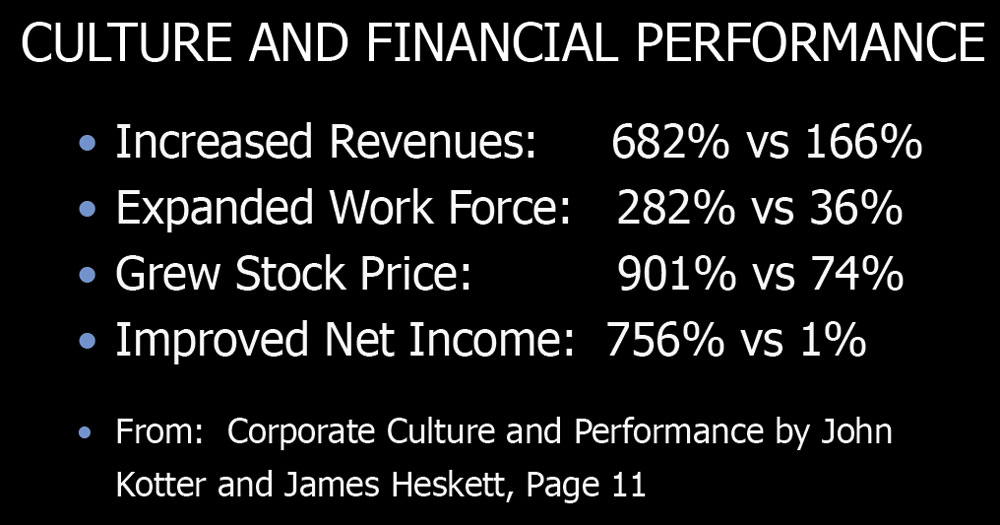
According to Corporate Culture and Performance by John Kotter and James Heskett, firms with cultures emphasizing all key managerial constituencies and leadership from managers at all levels significantly outperformed those who didn’t. Click to enlarge photo
“You want to make money? You want to improve your performance? You want to grow your business? Then you make sure that you have the culture in place that is going to drive that business to Nirvana. We’re not going to get it by metrics, we’re not going to get it by standards as much as I love them. It is about the culture that exists in your dealership,” Weber says. “That’s what’s going to drive that profitability. It’s not going to be the absorption rate that I talked about earlier, which is a critical indicator. It’s not going to be the asset turn which I talked about, which is going to be help the cashflow. But it’s going to be, have you developed a culture of high expectation?”
A culture of high expectation is fostered through 12 specific characteristics, including market and customer orientation, ability to change, strategic focus, values & standards, rituals & ceremonies, concern for people, rewards & punishments, open communication, conflict resolution, Esprit De Corps, commitment and teamwork.
For more on what makes up each of these characteristics, read “Creating a Culture of High Expectations & Excellence."
So if your dealership doesn’t have a culture of excellence and high expectations, how do you change that? First, you need to determine the dealership’s existing image, Weber says. To do that you have to assess what your employees that about working for you through a climate survey. Next, asses what your customers think about the dealership. But, Weber says you don’t do this through a customer satisfaction survey the manufacturers send out. Come up with your own customer satisfaction questionnaire that will assess what they think of the dealership, but more importantly what they expect from it. Weber says then you measure the gap that exists between what customers expect and how you’re fulfilling those expectations.
After that, Weber recommends having all managers and all the salespeople complete a meaningful competitive advantage on how your dealership stands up against the competition. Then, formulate the image objectives you want to have in the dealership — a step Weber says is critical. (See Dr. Jim Weber’s Checklist on Formulating Image Objectives for the Sales Department.)
Dr. Jim Weber’s Checklist on Formulating Image Objectives for the Sales Department
Articulate Philosophy of Filling Customer Needs and Managing the Sales Department
- Enthusiasm to Preempt Negativity
- Marketing to Supersede Selling
- Planning and Follow-up to Transcend Presentations
- Listening to Outpace Speaking
- Goal Setting to Be Commonplace
- On-site Calls to Supplant In-Dealership Visits
- Customer Profiles to Be the Norm
- Account Analysis to Replace Business as Usual
- Customer Share to Usurp Market Share
- Sales Department Profitability to Trump Market Share
- Inventory Turnover to Overshadow WG Gross Margin
The final step is to audit the new image. Analyze employee and customer perceptions, formally evaluate all employees, and continue to measure the gap between the expectations.
Quoting Pericles in 482 B.C., Weber says “‘I am not as concerned with the enemy’s strategy as I am with our own mistakes.’ Now, what we have to do as a dealer principal, as a sales manager, is we’re the leader of this team, we’re the captain of the ship, we’re the Pericles of this dealership. We’ve got to overlook what we’ve done in the past. We’ve got to create the ability to change, have the ability to change, and put the changes in place in a way that’s going to develop that positive culture that is going to help you grow the image that you need to sustain the ongoing operation as prosperous and as profitability and as cashflow-driven as you can possibly put in place.”
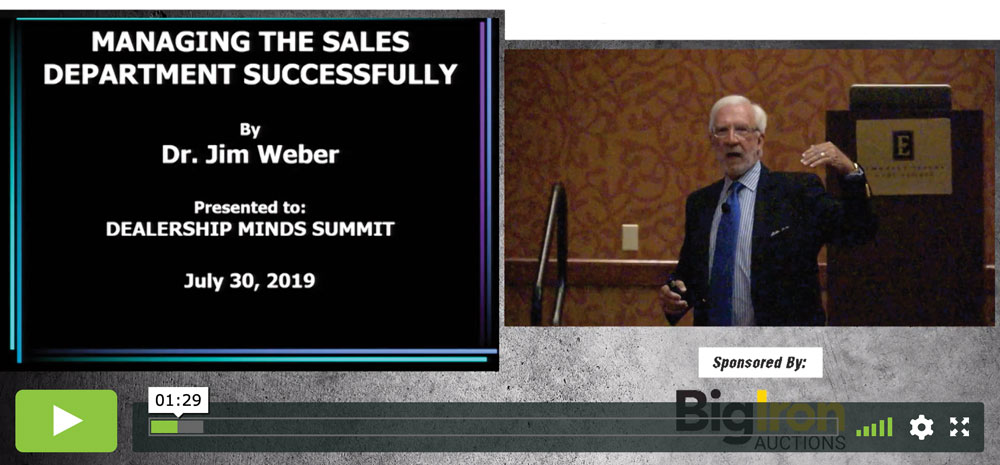
Related Content
- 5 Types of Dealership Cultures: Developing a professional culture based on unrelenting standards and high expectations is crucial for equipment dealers.
- Creating a Culture of High Expectations & Excellence: A culture of high expectation is fostered through 12 specific characteristics, including market and customer orientation, ability to change, strategic focus, values & standards, rituals & ceremonies, concern for people, rewards & punishments, open communication, conflict resolution, Esprit De Corps, commitment and teamwork.
- The Power of Employee Engagement: Employees are the dealership's most valued assets. Learn more on how to achieve financial success in this free webinar.
- Sure-fire Strategies for Sales Success: Dr. Jim Weber 's 2019 Dealership Minds Summit presentation addresses the specific activities that must be implemented to keep your sales team focused on selling, with clear goals.
- 4 Steps to Turn Used Equipment Into Cashflow: Consultant Dr. Jim Weber urges dealers to buy smart, limit reconditioning, be attentive to sales mix and compensate sales on what matters most.
- Business of Selling with Dr. Jim Weber column archive
More Dealership Minds Summit coverage
No More Order Takers: Strategies for Motivating & Improving Your Sales Team
8 Factors for Cultivating & Promoting a Professional Culture of Excellence
Compensation Plans: A Tale of Two Dealerships
Van Wall Equipment’s Formula for Clear Sales Strategy
No Sales Left Behind: Using Tech to Boost Your Sales Team
Ritchie: Create a Team of Solution Sellers
Feed Your Sales Team — A Presentation From Shawn Skaggs
The On-Farm Visit: How to Get the Most from Client Face Time
Adding Specialized Product Lines Can Expand Your Customer Base
Getting the Salesforce Out of the Dealership & In Front of the Customer
Purchase Projections: Look Beyond the Sale
3 Ways to Get Your Aftermarket Team to Adopt a Sales Mentality







